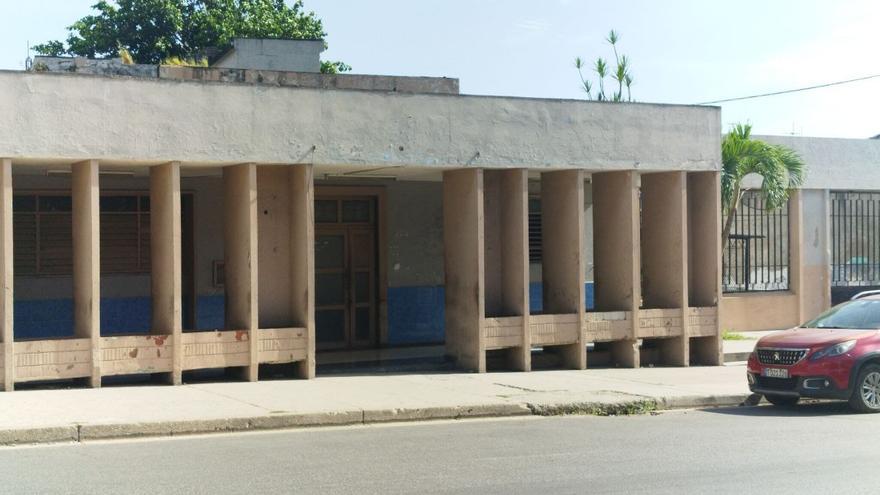
![]() 14ymedio, Juan Diego Rodríguez, Havana, 18 July 2023 — The residents of the Luyanó neighborhood in Havana have been without funeral services for two and a half years. Complaints have already begun to materialize in posts and comments on social media. However, with its doors closed and an empty outdoor entrance, the funeral home remains abandoned and without hope of resuming its functions.
14ymedio, Juan Diego Rodríguez, Havana, 18 July 2023 — The residents of the Luyanó neighborhood in Havana have been without funeral services for two and a half years. Complaints have already begun to materialize in posts and comments on social media. However, with its doors closed and an empty outdoor entrance, the funeral home remains abandoned and without hope of resuming its functions.
“The deceased are sent to San Miguel del Padrón or La Víbora,” a neighbor — who witnesses how, and how often, someone comes by the premises to ask about the restart of services — tells this newspaper.
“Since the pandemic began, they announced that they would no longer be accepting deceased. But the pandemic is over and the funeral home is still completely closed,” she laments.
In funeral homes in other neighborhoods of the capital, the situation is very reminiscent of the times when health restrictions prevented more than two people from attending a burial. The explanation? The transportation crisis. “It is very difficult to go to a wake at a funeral home that is not the one in your neighborhood, if you have no transportation. People are very limited, especially older people. Now everyone has to settle for offering their condolences to the family, while the mourners are left practically alone in the room with the deceased.”
In funeral homes in other neighborhoods of the capital, the situation is very reminiscent of the times when sanitary restrictions prevented more than two people from attending a funeral
A Facebook post by a group of Luyanó residents questioned the measure of having the memorial services for the deceased held in other centers, if the neighborhood has its own funeral home. “They always have a different problem. When the bathrooms are backed up, leaks appear; they must be repaired, painted, or the cafeteria has no water. It’s all a lie,” commented an enraged user.
“It is our funeral home, where we have always watched over our relatives, friends and all our people from Luyanó, why can’t we have this funeral service available?” lamented another Internet user.
It is not the first time that the population has complained about the lack of funeral services on the Island. From corpses that must wait hours –sometimes days– for a hearse to transport them, to the shortage of coffins to bury them, the bureaucracy of death in Cuba becomes increasingly suffocating for those who must deal with it.
In the Sancti Spíritus province, the construction of a crematorium has been expected for at least two years. With an investment of just 5 million pesos, the project could ease the burden of the relatives who transport their deceased to Ciego de Ávila or Villa Clara to comply with the wishes of the deceased to be cremated.
However, so far, the project has seen two location changes, several complaints from architects and no facility has been built.
“This is about advanced technology that requires two gas burners: one at the bottom, which is where the first cremation of the deceased is carried out, and a second, located in the tower where the gases that can rise into the atmosphere can be burned, so that only vapor comes out,” Yoel Aquiles Martínez, director of the province’s Provincial Unit of Necrological Services, told the Escambray newspaper.
Now everyone has to settle for sending their condolences to the family, while the mourners are left practically alone in the wake room with the deceased
The crematorium would also provide incineration services for medical and biological waste derived from hospital care, such as surgical remains and chemical and biological products. The managers do not say, however, what has been the fate of this waste so far.
The facility, initially projected to be built in an area chosen by specialists and architects on the border with Jatibonico, is now planned to be built 300 meters from the La Rosita residential area, because this would reduce construction costs.
Although the director of Public Health in the province has already authorized the new location, it has been rejected by the Hygiene area, which alleges that the expulsion of toxic gases derived from the cremation processes could harm the health of the residents of the area.
While Sancti Spíritus remains one of the four Cuban provinces that lacks a crematorium, institutions extend the timing with their internal confrontations. However, official sources, once again, point to the embargo as the culprit.
Translated by Norma Whiting
____________
COLLABORATE WITH OUR WORK: The 14ymedio team is committed to practicing serious journalism that reflects Cuba’s reality in all its depth. Thank you for joining us on this long journey. We invite you to continue supporting us by becoming a member of 14ymedio now. Together we can continue transforming journalism in Cuba.
